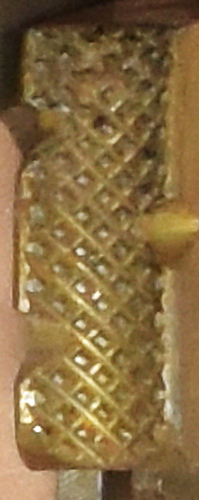Technical Details
I acquired this ascender from Artyom Babin (Артём Бабин) in 2024
 This ascender is 181 mm. tall, 93 mm. wide, 31 mm. thick, and weighs 216 g. The shell is a tall irregular shaped stamping made from 3.9 mm.
aluminum alloy sheet metal. A 16 mm. rope channel is formed in the upper
portion of one side and a smaller cam channel lies opposite the
first. A hole drilled through both sides of the cam channel accepts
a 6 mm. semi-tubular rivet. The cam and cam spring are mounted
on this rivet. The cam axle is centered 51 mm. from the inside of the rope channel.
This ascender is 181 mm. tall, 93 mm. wide, 31 mm. thick, and weighs 216 g. The shell is a tall irregular shaped stamping made from 3.9 mm.
aluminum alloy sheet metal. A 16 mm. rope channel is formed in the upper
portion of one side and a smaller cam channel lies opposite the
first. A hole drilled through both sides of the cam channel accepts
a 6 mm. semi-tubular rivet. The cam and cam spring are mounted
on this rivet. The cam axle is centered 51 mm. from the inside of the rope channel.
The handle is molded from red plastic. The handle front side of the handle does not extend as far up the front strap as the rear does. This is to provide cam clearance. A 14.7 mm. sling attachment hole is punched below the handle opening. A 14.3 mm. hole through both sides of the rope channel provides an attachment point just above the cam.
The cam is milled from steel plate and then plated. The cam radius, measured from the axle axis, increases from 39 to 54 mm. over an angle of 39°, giving a 25° cam angle. The teeth are pyramidal, formed by criss-crossing v-shaped cuts. The tooth pattern is (3.4)(5.4)^12(3). There are two v-shaped notches on the rear side of the cam and one on the front. These appear to be for mud relief.
A spring-loaded manual safety bar is mounted on the bottom of
the cam with a steel semi-tubular rivet. The normal action
of the spring holds the safety against the cam. When the cam is
opened, the shell interferes with the safety bar, thus preventing
opening the cam. If the safety bar is moved away from the cam
(opposing the spring), it will clear the shell and the cam will
open. At full open the safety can be released and the spring will
hold the safety against the back of the shell. This provides a
means of locking the cam open. A knob on the safety bar assists
in operating the safety mechanism.
There are no markings on this ascender.
This ascender is very well made for its time.
The cam is unusual. Steel cams wear better than aluminum. Milling avoids the complexity and expense of casting steel (or stainless steel) for low-volume production. The plating is effective, as there is no rust on this ascender's cam
I find opening the ascender with the right hand to be reasonably easy, but getting the safety to latch afterward is difficult. Opening with the opposite hand is far more difficult.
History
We have no information on this ascender's history other than it was made in the USSR in the 1970s or 1980s.

For far more content, use a larger monitor and a full-width window.
Hundreds of cell phone users complained and asked me to for a simpler, mobile friendly site. In particular, they wanted me to limit each page to a small number of pictures and minimize my use of text. This new site provides what they asked for.

